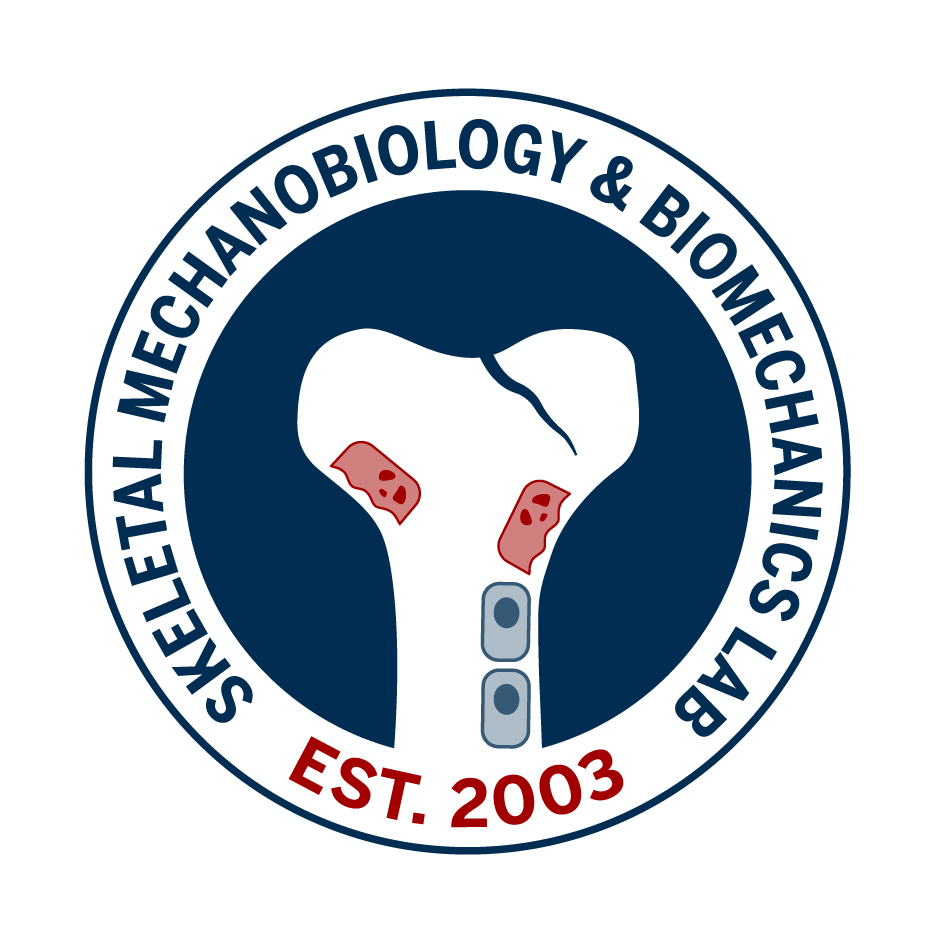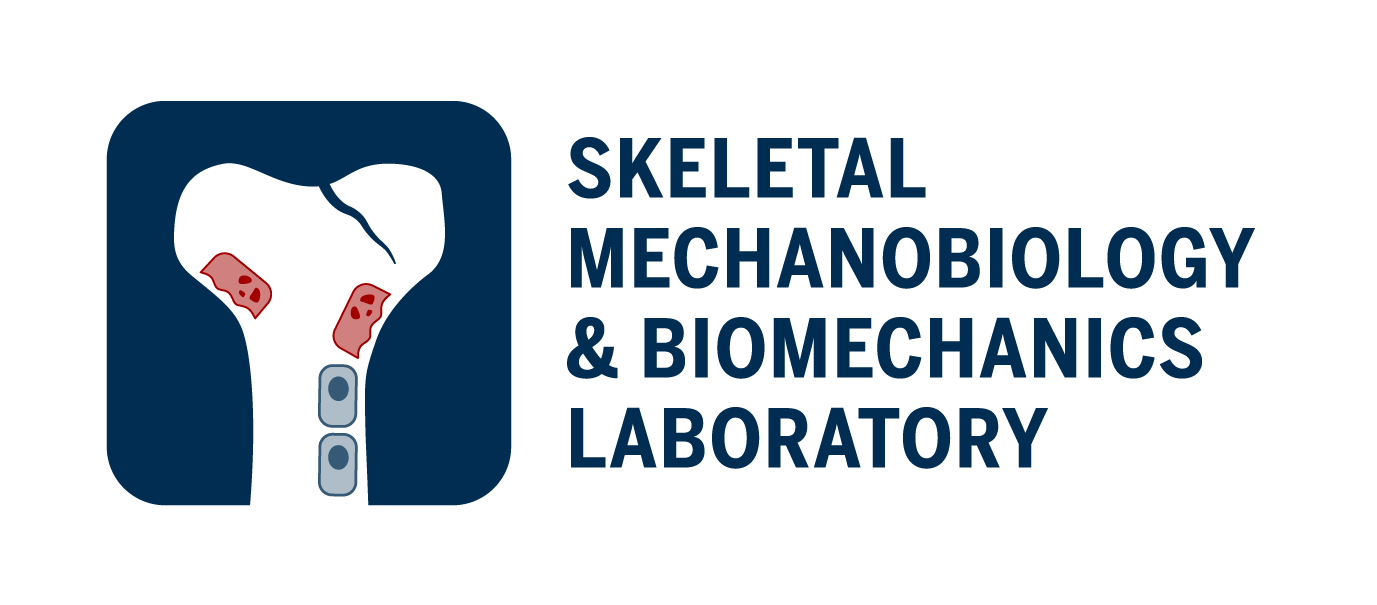RESEARCH
Our laboratory uses experimental and computational methods to explore the relationships between the structure and mechanical function of skeletal tissues at multiple length scales. Current research projects can be explored by clicking the titles below.
Mechanobiology of Bone Regeneration
Skeletal tissues such as bone and cartilage exhibit exquisite sensitivity to their mechanical environment, and this sensitivity is acutely apparent following injury. Numerous studies have demonstrated that altering the mechanical environment of an injured bone or joint surface can profoundly affect the healing response, in some cases producing a better repair outcome. However, despite the many examples of the mechano-responsiveness of skeletal tissues during healing, the mechanisms underlying this phenomenon remain poorly understood. Our group seeks to identify the specific mechanical stimuli that promote formation of bone and other musculoskeletal tissues during healing.

Key Papers
- Miller GJ, Gerstenfeld LC, Morgan EF. Mechanical microenvironments and protein expression associated with formation of different skeletal tissues during bone healing.
Biomech Model Mechanobiol. 2015 Nov;14(6):1239-53. doi: 10.1007/s10237-015-0670-4. - Morgan EF, Salisbury Palomares KT, Gleason RE, Bellin DL, Chien KB, Unnikrishnan GU, Leong PL. Correlations between local strains and tissue phenotypes in an experimental model of skeletal healing. J Biomech. 2010 Aug 26;43(12):2418-24. doi: 10.1016/j.jbiomech.2010.04.019.
Biomechanics of the Proximal Femur
When healthy, our bones are well adapted to withstanding the forces we exert on them in daily activities. But what about when they encounter unusual, and possibly extreme, forces? And what if the joint the bone is a part of is not healthy, such as happens with arthritis?
Key papers
- Fleps I, Morgan EF. A Review of CT-Based Fracture Risk Assessment with Finite Element Modeling and Machine Learning.
Current Osteoporos Reports. 2022 Oct;20(5):309-319. doi: 10.1007/s11914-022-00743 - Auger JD, Naik AJ, Murakami AM, Gerstenfeld LC, Morgan EF. Spatial assessment of femoral neck bone density and microstructure in hip osteoarthritis. Bone Reports 2021 Dec 9;16:101155. doi: 10.1016/j.bonr.2021.101155.

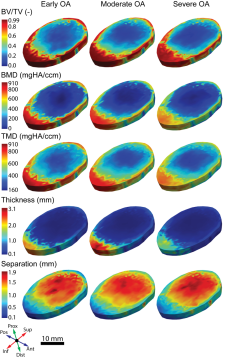
Biomechanics of Vertebral Fractures
Spine fractures are the hallmark of osteoporosis, affecting one in three women and one in five men over the age of 50. Yet how these fractures occur and what factors affect the likelihood of fracture remain poorly understood. Our laboratory has developed an experimental method for 3-D, quantitative visualization of the initiation and progression of spine fractures. This method is based on volumetric digital image correlation (VDIC; or digital volume correlation (DVC)) and is suitable for quantifying the highly non-uniform deformation fields—both throughout the interior of the bone and on bone surface—that occur during failure. With this method, we have been able to identify microstructural and anatomical features that are associated with initiation and propagation of failure. Our results provide a strong biomechanical rationale for one of the clinical methods used to screen for vertebral fracture; however, they also counter pervasive assumptions that regions of low density in the vertebra are the “weak links” and fail first.

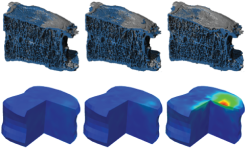
Key Papers
- Wu Y, Loaiza J, Banerji R, Blouin O, Morgan E. Structure-function relationships of the human vertebral endplate. JOR Spine. 2021 Sep 13;4(3):e1170. doi: 10.1002/jsp2.1170.
- Kaiser J, Allaire B, Fein PM, Lu D, Adams A, Kiel DP, Jarraya M, Guermazi A, Demissie S, Samelson EJ, Bouxsein ML, Morgan EF. Heterogeneity and Spatial Distribution of Intravertebral Trabecular Bone Mineral Density in the Lumbar Spine Is Associated With Prevalent Vertebral Fracture. J Bone Miner Res. 2020 Apr;35(4):641-648. doi: 10.1002/jbmr.3946.
- Jackman TM, Hussein AI, Curtiss C, Fein PM, Camp A, De Barros L, Morgan EF. Quantitative, 3D Visualization of the Initiation and Progression of Vertebral Fractures Under Compression and Anterior Flexion. J Bone Miner Res. 2016 Apr;31(4):777-88. doi: 10.1002/jbmr.2749.
Autonomous Experimentation and Design
(In collaboration with Keith Brown) Autonomous experimentation brings together automation and machine learning to rapidly advance the pace and efficiency of empirical research. Autonomous experimentation represents a new frontier in human-machine partnerships in which our own creativity and insight is augmented and accelerated.
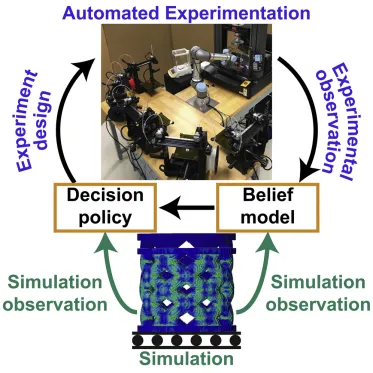
Key papers
- AE Gongora, KL Snapp, R Pang, TM Tiano, KG Reyes, E Whiting, TJ Lawton, EF Morgan, KA Brown. Designing lattices for impact protection using transfer learning. Matter. 5 (9), 2829-2846. doi.org/10.1016/j.matt.2022.06.051
- Gongora AE, Xu B, Perry W, Okoye C, Riley P, Reyes KG, Morgan EF, Brown KA. A Bayesian experimental autonomous researcher for mechanical design.
Science Advances. 2020 Apr 10;6(15): eaaz1708. doi: 10.1126/sciadv.aaz1708.
Skeletal Development and Homeostasis in Health and Disease
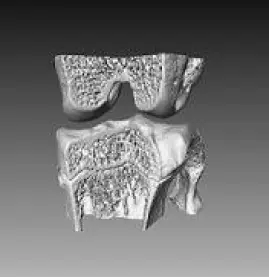
Key Papers
- Nakasone A, Guang Y, Wise A, Kim L, Babbin J, Rathod S, Mitchell AJ, Gerstenfeld LC, Morgan EF. Structural features of subchondral bone cysts and adjacent tissues in hip osteoarthritis.
Osteoarthritis Cartilage. 2022 Aug;30(8):1130-1139. doi: 10.1016/j.joca.2022.03.013. - Lu D, Demissie S, Horowitz NB, Gower AC, Lenburg ME, Alekseyev YO, Hussein AI, Bragdon B, Liu Y, Daukss D, Page JM, Webster MZ, Schlezinger JJ, Morgan EF, Gerstenfeld LC. Temporal and Quantitative Transcriptomic Differences Define Sexual Dimorphism in Murine Postnatal Bone Aging. JBMR Plus. 2021 Dec 10;6(2):e10579. doi: 10.1002/jbm4.10579.
- Nowlan NC, Jepsen KJ, Morgan EF. Smaller, weaker, and less stiff bones evolve from changes in subsistence strategy.
Osteoporos Int. 2011 Jun;22(6):1967-80. doi: 10.1007/s00198-010-1390-3.
